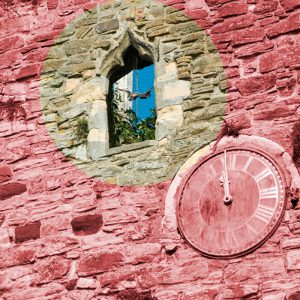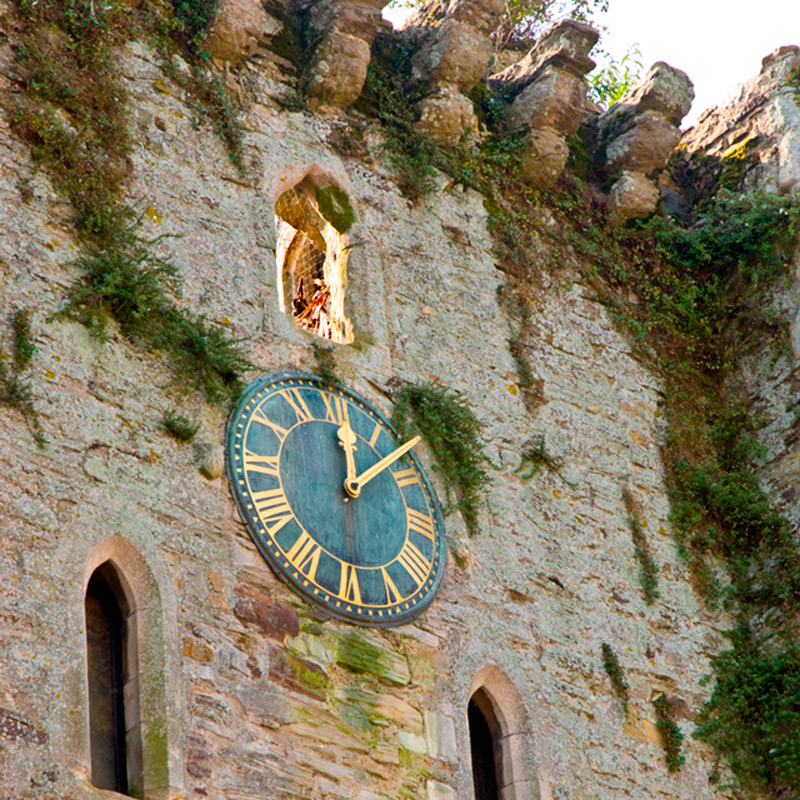Many people who live in and around Rye probably rarely take the time to look up at the front of the Landgate Tower these days. After all, it is a very familiar landmark and generally, if you are driving or walking around, most of your attention is likely to be focused on the dangers underneath it – tourists who stand in the middle of the road taking photographs, cyclists sometimes travelling at speed the wrong way underneath it, or even worse, as occasionally happens, other vehicles doing the same!
But if you do take a moment to look up at the tower you will see an increasingly sad sight. There is the discoloured stonework, the faded clock face with its stalled mechanism and, above that, the central window through which bits of dead birds hang suspended in the netting, clearly visible from the road. At the very top there is a dilapidated flagpole from which no flag ever flies. At night now, just one solitary pavement floodlight remains working from the set installed at great expense back in 2006.
The Landgate Tower, the last of the original gateways built into the town walls, has stood there since 1340. It is one of the most immediately identifiable and defining features of the town. Responsibility for its repair and upkeep rests with Rother District Council. However, a combination of a lack of funding and a complex and often difficult relationship between Rye council and the district council has resulted in a kind of stalemate concerning the maintenance and upkeep of the ancient building.
These days nobody in Rye has a key to the tower and Rother no longer sends anyone to maintain it, unless the stonework is damaged. The interior is notoriously unhygienic, principally because of the unchecked pigeon infestation. Some years ago nets were installed to help to prevent this problem, but they have been damaged, probably by bad weather, and consequently some birds have become trapped in the mesh and are left there to rot away.
The town council has offered to provide flags for the flagpole, but these can be hoisted only by personnel from Rother, which to date has declined to do so. Inquiries have been made by the town clerk regarding the restoration of the floodlights, which originally cost £15,000 and were paid for by European grant money raised by Rye Partnership. However, Rother has responded by requesting another £7,000 for their repair. And the question is, with the tower in its current state, who would want to look up at the long shadows thrown across the stonework by unchecked vegetation and rotting avian carcasses anyway?
Regarding the Landgate Tower clock, local historian Frank Palmer confirms it was installed in 1863, having been funded by public subscription, as a memorial to the passing of Prince Albert. Palmer used to climb the tower himself to wind the mechanism, but after he raised concerns with Rother about the interior state of the building, he was no longer allowed to do so on health and safety grounds. Eventually, an electric mechanism was added to allow the clock to run continuously unaided. However, at some point, nobody seems quite sure when, that mechanism also failed. With the locks on the tower changed, no one could go in to ascertain what was wrong with it.

In recent years, after a number of serious road incidents, concerns began to be raised about the frequency with which large, unsuitable vehicles were trying to gain access to the town through the archway. On one occasion a lorry became entirely stuck and, on another, the windows of a coach full of schoolchildren were smashed as it hit the stonework. This problem was eventually resolved by the provision of better warning signage – although this appears to have gone missing recently (see No warning for coach).
Rye Conservation Society is campaigning to get Rother to take some action to restore the tower. It has requested that its own experts be allowed to inspect the interior, but has so far been unable to make any progress. It is my understanding that the society has now asked an independent body, English Heritage, to place the monument on its At Risk register. Meanwhile, town councillor Mary Smith is writing to the amenities department at the district council to find out more details of why no action is being taken.
The problems with the Landgate are just some of the many that the town of Rye faces at present, problems that have been well documented in this newspaper and elsewhere, not least with traffic, parking, emergency access, supermarket planning and so forth.
As we all know so well, the town council has only limited powers and resources with which to address these matters and is often caught up in a labyrinth of logistical difficulties with the district council and other authorities. Yet the clock in the tower that greets us every time we turn up through the Landgate arch – with its two faded faces, failed power circuits and cogs that no longer mesh or turn properly – has become an unfortunate symbol of the current political and practical stuckness of this very historic town.
Perhaps it is time for individual councillors, residents, campaigning societies and others to join forces to remind Rother that it does have a responsibility to ensure that the Landgate Tower is restored and properly maintained.
Perhaps there are wealthy philanthropists or charitable organisations out there who could combine forces to restore the illumination and return the clock to working order.
Perhaps we could even have a magnificent new clock with its own subtle illumination. Just imagine, at the entrance to the town, instead of what is increasingly looking like some kind of great macabre shrine, decorated with weeds and dead pigeons, we could have a cleaned and restored Landgate Tower that actually welcomes visitors from all over the world, with a bright flag flying over it and a cheerful, working clock.

Photos: Nick Taylor
Image Credits: Tony Nunn .



